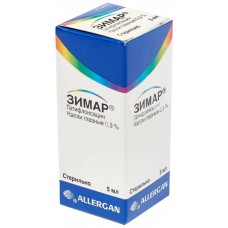Expiration date: 11/2026
Pharmacological action
Antimicrobial agent of fluoroquinolone group. Bactericidal action of Gatifloxacin, as well as other fluorinated quinolones, due to its ability to block the bacterial enzyme DNA gyrase. DNA gyrase is an important enzyme involved in the replication, transcription and repair of bacterial DNA. Gatifloxacin also suppresses topoisomerase IV, which plays a key role in the division of chromosomal DNA during bacterial cell division. Antibacterial spectrum includes resistance to penicillins, aminoglycosides, cephalosporins, as well as multi-resistant microorganisms.
Active against gram-positive microorganisms: Staphylococcus aureus, Streptococcus pneumoniae (including penicillin-sensitive and penicillin-resistant strains), Streptococcus pyogenes, Streptococcus saprophyticus, Staphylococcus epidermidis (methicillin-susceptible strains), Streptococcus spp. (groups C, G , F), Streptococcus agalactiae, gram-negative microorganisms: Escherichia coli, Haemophillus influenzae (including strains producing ?-lactamases), Haemophillus parainfluenzae, Klebsiella pneumoniae, Moraxella catarrhalis (including strains producing ?-lactamases), Neisseria gonorrhoeae (including strains producing ?-lactamases), Proteus mirabilis, Acinetobacter iwoffii, Citrobacter koseri, Citrobacter freundii, Enterobacter aerogenes, Enterobacter cloacae, Klebsiella oxytoca, Moragnella morganii, Proteus vulgaris, other microorganisms: Chlamydia pneumoniae, Legionella pneumophila, Mycoplasma pneumoniae.
Highly active against anaerobes, in particular Peptostreptococcus spp.
Pharmacokinetics
The pharmacokinetics of Gatifloxacin is linear and does not depend on time when used in doses from 200 to 800 mg for up to 14 days.
After oral Gatifloxacin is well absorbed from the gastrointestinal tract. Absolute bioavailability of Gatifloxacin is 96%. Cmax Gatifloxacin in plasma is usually achieved after 1-2 h after administration.
The binding of Gatifloxacin to plasma proteins is about 20% and does not depend on the concentration. Gatifloxacin is widely distributed in many tissues and body fluids (including bronchial mucosa, alveolar macrophages, vagina and cervix). The rapid distribution of Gatifloxacin in the tissue leads to higher concentrations in most target organs than in serum.
Gatifloxacin undergoes limited biotransformation in the body. Less than 1% of the administered dose is excreted in the urine in the form of Ethylenediamine and methylethylenediamine metabolites. Unchanged excreted mainly by the kidneys (more than 70% within 48 hours after ingestion), 5% excreted in the feces
Indications
Infectious and inflammatory diseases caused by sensitive microorganisms: pneumonia, chronic bronchitis in the acute phase, pyelonephritis, complicated and uncomplicated urinary tract infections, ENT infections, including acute sinusitis, skin and soft tissue infections, sexually transmitted diseases (urethritis, cervicitis, proctitis).
Dosage regimen
Taken orally at a dose of 200-400 mg 1 time/ Duration of treatment depends on the indications and severity of infection.
The initial dose of the drug in renal insufficiency does not differ from the dose for patients with normal renal function, further dosing regimen is established depending on the QC.
Side effect
From the digestive system: nausea, vomiting, abdominal pain, anorexia, diarrhea, constipation, dyspepsia, flatulence, gastritis, glossitis, stomatitis, gingivitis, gastrointestinal bleeding.
On the part of the NCC and peripheral nervous system: headache, dizziness, migraine, insomnia and other sleep disorders, agitation, anxiety, nervousness, confusion, drowsiness, paresthesia, tremor, convulsions, convulsions of the muscles of the lower extremities, depersonalization, depression, panic attack, paranoia, hostility, photophobia, ataxia, hyperesthesia, visual impairment, photosensitivity of the eyes, distortion of taste sensations, parosmia, peripheral neuropathy.
From the cardiovascular system: tachycardia, bradycardia, hypertension.
From the musculoskeletal system: increased risk of tendon rupture, ossalgia, arthritis.
From the respiratory system: hyperventilation, bronchospasm.
Allergic reactions: swelling of the face, swelling of the mucous membrane of the mouth and tongue, generalized edema, macular-papular rash, vesicular rash.
Other: chest pain, ear pain, thirst, dry skin, fever, vaginitis, hypoglycemia, hematuria, metrorragia.
Contraindications
Childhood and adolescence to 18 years, pregnancy, lactation (breastfeeding), hypersensitivity to Gatifloxacin or other fluoroquinolones.
Use during pregnancy and breast-feeding
Contraindicated use during pregnancy and lactation (breastfeeding).
Use in renal impairment
The initial dose of the drug in renal insufficiency does not differ from the dose for patients with normal renal function, further dosing regimen is established depending on the QC.
Use in children
Contraindicated in childhood and adolescence to 18 years.
Special instruction
Gatifloxacin may cause an increase in the duration of QT intervals on ECG in some patients. Due to insufficient clinical experience, Gatifloxacin should not be used in patients with long Qt interval, hypercalcemia and while taking antiarrhythmic drugs of class I A (quinidine, procainamide) or class III (amiodarone, sotalol).
Gatifloxacin should be used with caution in patients with bradycardia and acute myocardial ischemia.
Like other fluoroquinolones, Gatifloxacin should be used with caution in patients with severe cerebral atherosclerosis, epilepsy and diseases that can cause seizures.
Impact on the ability to drive and operate machinery
During treatment, the rate of psychomotor reactions may decrease, so patients should refrain from driving and working with dangerous mechanisms.
Drug interaction
During treatment, there may be changes in blood glucose (symptomatic Hyper-and hypoglycemia) in patients with diabetes, taking oral hypoglycemic drugs (it is recommended to carry out regular monitoring of blood glucose).
Gatifloxacin should be taken 4 hours before taking iron sulfate, dietary supplements containing zinc, magnesium or iron, antacids containing magnesium and aluminum compounds.
Excretion Gatifloxacin is increased with simultaneous use with probenecid.
While the use of Gatifloxacin with warfarin revealed no significant changes in blood clotting time. But given the ability of some quinolones to enhance the effect of warfarin or other indirect anticoagulants, while their use should be monitored prothrombin time or other indicators of blood clotting.
Simultaneous use of NSAIDs with fluoroquinolones may increase the risk of side effects from the CNS.
With careful use concurrently with cisapride, erythromycin, antipsychotic drugs.
Zimar
(Gatifloxacin)
0.3%
5ml
eye
drops
- Brand: Allergan


